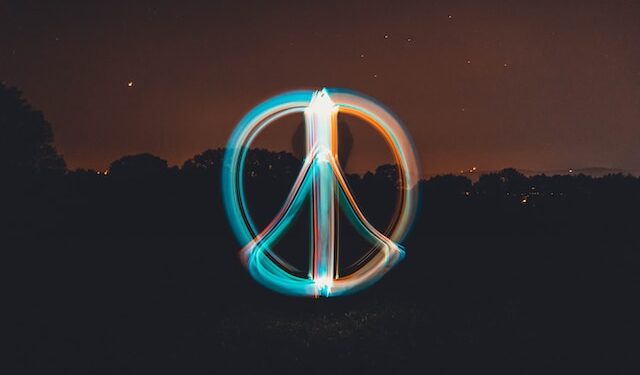What Color Is The Peace Sign
The Peace Sign, a recognizable symbol widely used, holds an essential place in the public consciousness as a symbol that inspires hope, peace, and peace. However, one aspect of the character attracts attention: the color. What hue is the peace sign’s color, and does that color have any significance? It may appear simple at first glance, but looking deeper into the meaning and the history behind the colors of the peace sign uncovers a rich tapestry of purposes and interpretations.
In this journey, we will decode the mystery surrounding the hue of the peace symbol and its history, as well as reveal the significance of its symbolism and explore the various regional and cultural variations that have developed over time. From the initial black and white style, the colorful rainbow variants, and the debates and debates over the color of the peace sign, this trip will provide insight into the intriguing universe of one the oldest images of peace, harmony, and harmony. Join us on a vibrant journey to find out what color represents the essence of the peace symbol.
Origin And History Of The Peace Sign

A symbol as powerful and well-known as the peace sign has to have an interesting story behind its creation. In this article, we will explore the history of this enduring symbol and the evolution of its history.
1. The creation of the peace symbol in the 1950s
- The peace sign, which is also called the peace symbol or CND symbol, was invented in the turbulent times in the 1950s.
- Its place of birth: Britain. It was an outrage against nuclear weapons and the imminent danger of nuclear war in the Cold War era.
- The campaign for nuclear Disarmament (CND) had the leading role in the spread of the symbol as a symbol of the peace process and disarmament.
2. Gerald Holtom and his original design
- Gerald Holtom, a British designer and pacifist, is recognized for the creation of the peace symbol in the year 1958.
- The design is an elegant and effective combination of a circular shape with three downward-pointing lines within.
- The lines are usually described as semaphore signals for “N” (nuclear) and “D” (disarmament) although Holtom himself was not clear on the meaning initially.
3. The significance of the circles, lines and angles
- The circle is usually seen as a symbol of Earth and the worldwide community.
- The three lines inside the circle, which form uninverted triangles, have inspired many interpretations:
- “Nuclear disarmament” is a clear message.
- A broken, upside-down cross that represents the need for peace during times of crises.
- The three lines can be a symbol of people who have arms outstretched, reaching for peace and harmony.
4. The first use of the peace sign in white and black
- The original version of peace symbols was white on black.
- The stark simplicity of the design resonated with peace and activist movement of the time.
- The stark monochromatic design was a powerful and strong visual appeal against the imminent nuclear threat.
The design and origin for the symbol that symbolizes peace laid the foundation for its long-lasting worldwide recognition as a symbol for peaceful protest and peace. Its origins are in the anti-nuclear revolution, and its simple but powerful design continues to draw the attention of people and groups that are dedicated to promoting peace and harmony.
The Symbolism Of Colors In The Peace Sign
The original peace sign’s design was black against white background, with time, different shades have been attributed to the iconic symbol. In this article, we’ll look at the meaning behind the color of the peace symbol and the ways they’ve come to symbolize different aspects of peace, unity, and activism.
1. White is the color of the original
The neutrality and purity of white
- White has been associated for a long time with simplicity, purity, and neutrality.
- In the context of the peace symbol, the original black symbol with a white background served as a striking illustration of the fresh slate that peace could offer in a world dominated by conflicts.
The peace movement during the 1960s, and the use of white
- In the 1960s, the peace movement adopted white as a symbol of peace and non-violence.
- White clothing and symbols came to be associated with peace protests, especially those in the United States.
2. The Rainbow Peace Sign
The rainbow is a symbol of diversity as well as inclusiveness
- The rainbow, along with its variety of colors, has become a symbol of diversity, inclusiveness, and acceptance.
- The rainbow peace sign reflects these values in peaceful movements.
LGBTQ+ rights and the rainbow peace sign
- The LGBTQ+ rights movement adopted the rainbow flag as a symbol of respect and pride.
- In certain situations, the rainbow peace sign can be used to express solidarity between peace activists as well as LGBTQ+ activism.
3. Other Color Variations
Red: Red is a color that has a connection to love and activism
Red is often associated with passion and love. It is often used in peace symbolism to express the human love and desire for peace.
It also represents the commitment and courage required for peace.
Green: The link to environmentalists
Green represents the environment and nature, and the environment has been used for peace signs to emphasize the importance of sustainable development for a peaceful planet.
Blue: The key to peace and diplomacy around the world
Blue, a color that is commonly associated with peace and stability, can be used to represent international peace and diplomacy efforts, especially when it comes to international relations.
The color choice in the peace sign permits the movement and individuals to provide different layers of significance to the sign. It doesn’t matter if it’s the classic black and white version the rainbow version, or any other color. Each color has its own distinct symbolism to convey the meaning of peace as well as harmony. These variations demonstrate the flexibility of the peace symbol in its role as an universal sign that has the ability to communicate various ideas and messages.
Cultural And Regional Variations

The Peace Sign, which conveys a eternal message of unity and peace, transcends geographical borders and linguistic differences. When it was spread throughout the globe, it was subject to different interpretations and modifications across diverse cultures and regions. In this article, we’ll examine how the peace symbol has changed in a variety of contexts of regional and cultural significance.
1. The various colors used in cultures
- Japan: Japan the peace symbol is often incorporated into the colors white and red which are the national flag’s colors. The symbol represents a need to be peaceful within the broader context of Japanese heritage and culture.
- India: India the peace symbol can be decorated with vivid colors and intricate patterns reflecting India’s extensive artistic tradition as well as the notion of unity within the diversity.
- Africa: In certain African countries the peace sign can be incorporated into traditional clothing and jewellery, showing the fusion of culture and an universal peace message.
2. Interpretations of the peace symbol
- Middle East: In the Middle East, where conflicts continue for decades, the peace symbol has gained more significance. It symbolizes the belief in the restoration of peace in a place stricken by tensions.
- Latin America: In countries such as Colombia, the peace sign has been accepted as a symbol of resilience and faith in the face of violence and conflict.
- Europe: Europe, which is where the peace symbol originated. The sign is frequently used to honor historic events such as the falling of the Berlin Wall and the end of the Cold War, emphasizing the importance of peace throughout the history of Europe.
A few examples of the ways in which peace symbol can be used in various contexts
- The religious symbolism: In certain regions the peace symbol can be combined with religious symbols, highlighting the link between religion and the search for peace.
- Expressions of art: Artists all over the globe have integrated the peace symbol in their work, making use of it to communicate the message of peace as well as social transformation.
- Movements of activists: In many nations, the peace sign has become a symbol of social movements. This includes protests against war, human rights initiatives, and environmental activism.
The regional and cultural variations of the peace sign show its versatility to be a universal symbol for optimism and a sense of unity. While its fundamental message is unchanged, the various interpretations and modifications are a reflection of the distinct experiences, aspirations, values, and beliefs of various regions and cultures and reinforce the notion of peace as a universal ideal.
Conclusion
In the end, the peace symbol, with its mysterious colors, is a powerful symbol of humanity’s longing for peace and harmony. Its humble beginnings as a black and white symbol on white backgrounds and has grown into a multi-colored symbol that transcends cultures and borders and represents a universal wish to live in a world without tension and conflict.
Its ability to adapt and grow in diverse regions and cultures highlights the lasting effectiveness of its identity. The peace sign continues to be accepted by movements, individuals, and communities around the world and serves as a reminder regardless of color or other variations, it is the quest for peace that is a common human desire that binds all of us on a worldwide journey towards a more peaceful future.
















